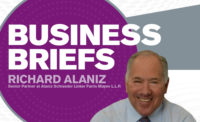When the 110-employee Crescent Parts and Equipment kicked off enrollment in its high-deductible health plan last October, it made employees a special offer that combined both physical and financial health.
Biweekly health premiums would remain unchanged for employees who got a biometric exam and signed up with HooPayz, a financial wellness company. It helps consumers learn how to shop for health care so the cost and complexity of care do not hurt their work and home life.
“We have always tried to make employees conscious of health care costs, but transparency has been an issue,” says Diane Gambaro, Crescent’s human resources manager. “We want to help employees see and compare the real costs. Any employee could sign up for the service regardless of whether they got the biometric exam, and all did.” Crescent is a leading HVACR wholesale distributor in the St. Louis region. It recently moved from a fully insured to a self-funded health plan while retaining its tiered, high deductible benefit design with a health reimbursement account.
Eight months into getting better health care deals, Crescent employees have saved an estimated $58,283 for themselves and their company. The biggest savings have come from using HooPayz personal advisers, who provide concierge service to employees and their families by phone six days a week.
Personal advisers have helped employees save an estimated $26,811, finding better prices, ensuring correct application of benefits, negotiating discounts, assisting with debt collection resolution and answering questions on medical, dental, vision and prescription benefits. The advisers also confirm quality and credentialing and can tell employees if a provider is in their network. Once an employee reaches out to a personal adviser with a question, that adviser works with the employee from beginning to end.
“Personal advisers also review bills for errors. Employees talk a lot about it because they never thought there would be so many errors. As an employer, we love it because our employees can get help instead of spending hours at work untangling bills,” explained Gambaro. Simply by helping employees spend less time on bills, the company has avoided an estimated 259 hours in lost productivity valued at $8,472.
Crescent employees are also talking about an employee who needed an expensive procedure. Options were limited where the employee lives, away from Crescent’s home office. With help from a personal adviser, the employee found that a few hours drive would save thousands of dollars. He was happy to make the trip. When another employee needed an MRI of the back, a personal adviser found three money-saving options, saving hundreds of dollars.
Personal advisers can also provide guidance for employee family members covered by other health plans. In one case recently, a spouse’s health plan said a specific procedure would cost $1,600. Questioning the high price for a simple imaging test, the employee used the HooPayz online tool to find a price of $138. Because of the large range in prices, the employee picked up the phone and called his personal adviser to ask why the pricing was so different.
Even though the spouse was not on the employee’s benefit plan, his personal adviser was able to explain that hospital providers are typically much more expensive. Then, the personal adviser directed the employee to a few imaging centers in the area that would be less expensive. Seeing an employee check prices, knowing there had to be a less expensive alternative, was exciting. In less than a year, the people of Crescent have become practiced health care shoppers.
Crescent launched its three-step program of education, support and tools in October like every other major initiative, during one of its regular 7:05 a.m. all-employee meetings. These sessions kick off each month with the latest company news and financial information.
HooPayz also conducted meetings and webinars at other times for employees and their families, custom designed to accommodate Crescent employee and family schedules. “Some employees made sure their spouses participated in one of the evening webinars,” says Gambaro. Emails to all employees summarized and supplemented the introductory information.
Employee education and engagement continued uninterrupted following the launch, especially around online tools. In addition to a powerful shopping and price comparison tool, additional online tools help with reviewing bills, tracking deductibles and creating health care budgets.
Learning how to shop for health care can be fun, as Crescent employees discovered during a virtual scavenger hunt using the shopping tool. Prizes went to employees who used the tool to find the best deals for quality health care. They saw how procedures typically cost more at hospitals than at standalone facilities simply because of higher overhead.
In another initiative, Crescent offered employees a cash incentive to those who shopped for any of three different procedures, used a “green” fair price provider and then submitted their explanation of benefits (EOB) for verification. The procedures included MRIs, CT scans and colonoscopies.
Meanwhile, Crescent was experiencing an uptick in prescription drug costs spurred, in part, by several high-cost specialty drugs. It responded with a customized, monthly information campaign, including emails and other materials, to educate the company’s employees on ways to pay less for prescription drugs. Posters also appeared at work sites and break rooms.
Employees have a stake in getting the cost of prescription drugs down because drug and medical costs are included in the same out-of-pocket maximum. Tips include comparing retail drug store prices, which can vary a lot, and tapping into pharmaceutical company co-pay support programs.
“Before, employees did not think about shopping for their health care. Now, they do. They are even sharing what they find out about price differences with each other by word of mouth,” says Gambaro. During the first eight months, employees saved an estimated $23,000 using the online tools to shop for better prices.
Especially impressive for Gambaro are the ongoing education process and high employee engagement; more than 70 percent have either used an online tool or contacted a personal adviser. “For sure, it is making employees more aware and changing habits,” she observed.
Gambaro says, “We have talked for so many years about getting employees to shop for health care. Now they and we have a way to be great health care shoppers.”







